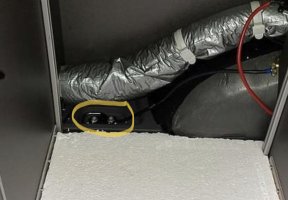Quote & contact details for retrofit below.
Image shows additional possible panels to bring up the capacity.
Thank you for your enquiry and interest in our products. Please excuse the delayed answer, we are receiving an extremely high number of requests at the moment.
We manufacture the original solar panels for the Grand California and have permission from VW to supply these identically - except for the connector and the VW label - to you as the end customer. It would also be possible to mount additional modules with up to 220Wp on top of the roof - enclosed you find a rendering with possible modules (depending on the configuration on the roof).
Here are the system costs (104Wp Grand California 600):
SolbianFlex custom VW GC600
€ 1126,68
Pre-mounted adhesive
€ 37,00
Victron SmartSolar 75/15
€ 120,00
Shipping EU
€ 12,90
TOTAL
incl. VAT
€ 1296,58
excl. VAT
€ 1080,48
…shipping to the UK is 80€.
There are no specific installation instructions for the VW module, but as the cables have already been placed here is some information:
- Enclosed you will find a picture showing the cable assignment on the original charge controller - the Victron controller is to be connected in exactly the same way. From the roof (the cover is fixed with Velcro) there should be cables in red (+) and black (-), these are connected to the PV connection. From the fuse block should come red with a white stripe (+) and brown (-), these cables are connected to the BATT connection. Unfortunately, we cannot guarantee that the cables have already been laid in your vehicle and that the cable colours correspond to this assignment, but so far this seems to be the case with all vehicles.
- Apart from our material, you only need tools and sealant for the joint around the module (Sikaflex 295-UV, see below).
Here is some more information about the installation:
Installation (2 people recommended):
Solar cells are relatively sensitive as long as they are not yet glued - handle them as carefully as possible and do not bend them too much.
1) Cut the protective film on the back in the area of the cables so that you can easily pull it off without getting caught on the cables.
2) Place the module on top and mark the cable positions. Then drill holes for the cables - we recommend a rectangular cut-out slightly larger than the cable foot with a multitool or jigsaw.
3) Clean the surface thoroughly, e.g. with acetone - it must be clean and free of grease.
4) Place the module on top and fix the half without cables with tape so that they can no longer slip.
5) Lift the module on the side of the cables, fold back the first 10cm of the protective film on the back and press the edge (approx. 1cm, not more!) of the module onto the roof. The tape can now be removed and the module can no longer slip.
6) While one person carefully lifts the module (the cells must not be bent strongly, which is why the area with cells should not yet be pressed on in step 5), the second person slowly pulls off the protective film and meanwhile presses the module onto the roof step by step with a cloth.
7) As soon as the entire module is glued on, carefully press the entire surface again, especially the area around the cable gland and the outer edges are important here.
For caulking, we recommend Sikaflex 295-UV in combination with smoothing agent N, which works much better with this sealant than soapy water. The edges of the module and vehicle should be masked off to protect them - we usually caulk as follows:
1) mask the edges
2) Apply sealant
3) Press sealant into joint with finger and plenty of smoothing agent to prevent air pockets and gaps.
4) Peel off excess sealant with jointing tool
5) Remove tape
6) Carefully finalise joints with finger and plenty of smoothing agent, here the edges remaining from the masking tape are still smoothed out
If you have any questions during the installation, please do not hesitate to contact us by phone.
With kind regards
Michael Körner
Sailectron GmbH
Michael Körner
Geschäftsführung | Sailectron GmbH
SOLBIAN Solar DE & AT
Neufeldweg 147F/2, A-8041 Graz
DE: +49 1520 4096530
AT: +43 650 5709366
web:
www.solbian.solar
email:
[email protected]



















